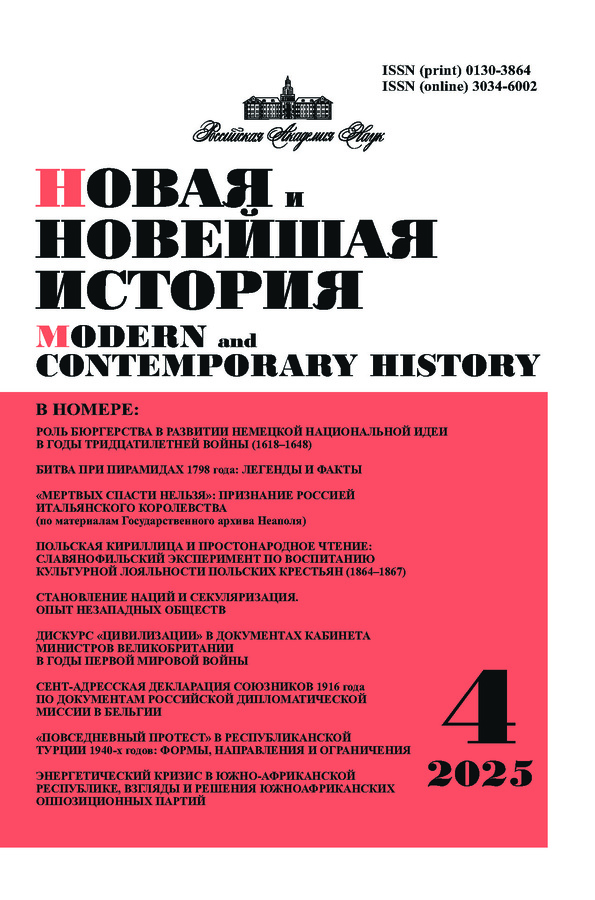Kyrgyz National-State Formation at the Turn of the 1910s–1920s: Interpretations in the Historiography of Independent Kyrgyzstan
- Authors: Yun S.M.1
-
Affiliations:
- National Research Tomsk State University
- Issue: No 4 (2025)
- Pages: 17-26
- Section: Theory and methodology of history
- URL: https://bakhtiniada.ru/0130-3864/article/view/316675
- DOI: https://doi.org/10.31857/S0130386425040025
- ID: 316675
Cite item
Abstract
About the authors
S. M. Yun
National Research Tomsk State University
Email: sergey.yun@mail.tsu.ru
Tomsk, Russia
References
- Abytov B. 1916 god: Polemika vokrug vosstania kyrgyzov (prodolzhenie). 28 ianvaria 2016 g. [1916: The controversy surrounding the Kyrgyz uprising (continued). January 28, 2016] // URL: https://kghistory.akipress.org/unews/un_post:7192 (access date: 24.12.2024). (In Russ.)
- Batyrbaeva Sh.D. Teoretiko-metodologicheskie aspekty issledovania demograficheskikh posledstvii vosstania 1916 g. v Severnom Kyrgyzstane [Theoretical and methodological aspects of the study of the demographic consequences of the 1916 Revolt in Northern Kyrgyzstan] // Turkestanskoe vosstanie 1916 g.: fakty i interpretatsii. Materialy Mezhdunar. nauch. konf., Moskva (23–24 maia 2016 g.) [Turkestan revolt of 1916: facts and interpretations. Materials of the International research conf., Moscow (May 23–24, 2016)] / otv. red. Ju.A. Petrov. Moskva, 2016. S. 38–51. (In Russ.)
- Budjanskij D.M. Istorija bezhencev-kyrgyzov (1916–1927 gody) [History of Kyrgyz refugees (1916–1927)]. Bishkek, 2006. (In Russ.)
- Chotonov U.Ch., Dosbol Nur uulu. Istorija Otechestva. Uchebnik dlja vuzov [History of the Fatherland. Textbook for universities]. Bishkek, 2009. (In Russ.)
- Imankulov M.K. Istorija Kyrgyzstana (XX–XXI vv.): 9 kl. Uchebnik dlja obshheobrazovat. shk. [History of Kyrgyzstan (20th–21st centuries): 9th grade. Textbook for comprehensive schools]. Bishkek, 2014. (In Russ.)
- Istoria Kirgizskoi SSR: S drevneishikh vremen do nashikh dnei. T. 2. Dobrovol’noe vhozhdenie Kirgizii v sostav Rossii i ego progressivnye posledstvia (razlozhenie patriarhal’no-feodal’nykh i razvitie kapitalisticheskikh otnoshenii, 1855 – mart 1917 g.) [History of the Kirghiz SSR: from ancient times to the present day. Vol. 2. Kirghizia’s voluntary entry into Russia and its progressive consequences (the disintegration of patriarchal-feudal relations and the development of capitalist relations, 1855 – march 1917). Frunze, 1986. (In Russ.)
- Istoria Kirgizskoi SSR: s drevneishikh vremen do nashikh dnei. T. 3. Pobeda Velikoj Oktiabr’skoi sotsialisticheskoi revoiiutsii i postroenie sotsializma v Kirgizii (1917–1937 gg.) [History of the Kirghiz SSR: from ancient times to the present day. Vol. 3. The victory of the Great October socialist revolution and the construction of socialism in Kirghizia (1917–1937)] / K.K. Karakeev (gl. red.) i dr. Frunze, 1986. (In Russ.)
- Kenesariev T. 1916-zhylky Uluu ukөtөrүlүshtүn өbөlgөlөrү zhana sebepteri. 19 iiulia 2016 g. [Background and Causes of the Great Revolt of 1916] // URL: https://kghistory.akipress.org/unews/un_post:7891 (access date: 15.03.2025). (In Kyrgyz)
- Kyrgyzy i Kyrgyzstan: opyt novogo istoricheskogo osmyslenia [The Kyrgyz and Kyrgyzstan: experience of new historical interpretation] / pred. red. T. Koichuev. Bishkek, 1994. (In Russ.)
- Moldokasymov K. 1916-zhyl. Jerkindik үchүn kүrөshtүn baraktary zhana sabaktary. 23 dekabrja 2011 g. [1916. Pages and lessons of the struggle for freedom] // URL: https://muras.turmush.kg/unews/un_post:2962 (access date: 15.03.2025). (In Kyrgyz)
- Mombekova Zh.K. Istorija kyrgyzov i Kyrgyzstana s drevnejshih vremen do nashih dnej [History of the Kyrgyz and Kyrgyzstan from ancient times to the present day]. Bishkek, 2020. (In Russ.)
- Omurbekov T.N., Chorotegin T.K. Istoria Kyrgyzstana (XIX v.): 8 klass. Uchebnik dlia obshheobrazovat. shk. [History of Kyrgyzstan (19th century): grade 8. Textbook for comprehensive schools]. Bishkek, 2014. (In Russ.)
- Osmonov O.Dzh. Istorija Kyrgyzstana (s drevnejshih vremen do nashih dnej). Uchebnik dlja vuzov. [History of Kyrgyzstan (from ancient times to the present day). Textbook for universities]. Izd. 6-e, ispravl. i dop. Bishkek, 2014. (In Russ.)
- Ploskikh V.M., Dzhunushaliev D.D., Abdyrahmanov T.A. Istoria kyrgyzov i Kyrgyzstana: uchebnik dlja vuzov [History of the Kyrgyz and Kyrgyzstan: textbook for universities] / otv. red. A.Ch. Kakeev. 3-e dorab. izd. Bishkek, 2015. (In Russ.)
- Shejshekanov T. Koldogu kotorulush [Revolt in Issyk-Kul]. Bishkek, 2003. (In Kyrgyz)
- Usenbaev K.U. Vosstanie 1916 goda v Kirgizii [The 1916 Revolt in Kyrgyzstan]. Frunze, 1967. (In Russ.)
- Vosstanie 1916 goda v Kyrgyzstane [The 1916 Revolt in Kyrgyzstan]. Bishkek, 1993. (In Russ.)
- Zhakypbekov Zh. Sotsial’no-ekonomicheskoe i politicheskoe razvitie Kyrgyzstana vo vtoroi polovine XIX – nachale XX vekov: Istoriografia problem [Social, economic and political development of Kyrgyzstan in the second half of the 19th – early 20th centuries: Historiography of problems]. Bishkek, 2003. (In Russ.)
Supplementary files









